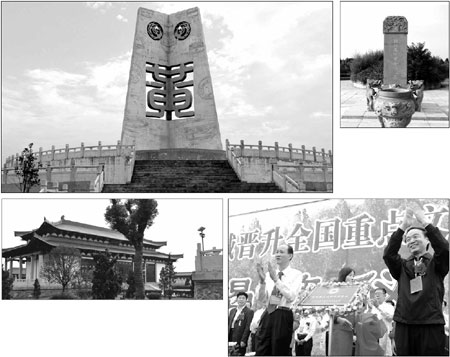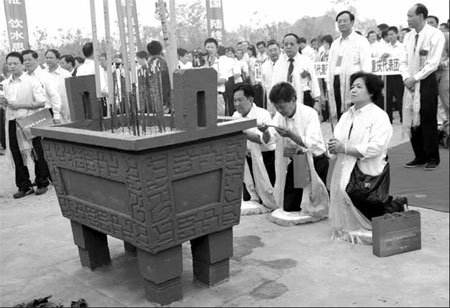Huangchuan’s first-half industrial output growth exceeds 20 percent
Updated: 2012-11-13 08:07
By Xiang Mingchao (China Daily)
|
|||||||||||
|
Clockwise from left: A monument highlights the Huang family name, which is one of the most common surnames in China. The mausoleum of Huang Xie, who was a descendant of former Huang Kingdom residents and later served the Chu Kingdom as prime minister during the Warring States Period (475-221 BC). A ceremony marking the induction of the well-preserved Huang Kingdom archeological site into the national cultural heritage protection list in 2007. The Huang Kingdom archeological site. Photos by Xiang Mingchao / China Daily |
|
Descendants of the ancient Huang Kingdom get together to worship their ancestors. |
Huangchuan's first-half industrial output growth exceeds 20 percent
Huangchuan county in the southeastern part of Henan province achieved healthy growth in the first half of the year, according to official statistics.
The county, which has a population of 800,000, generated an industrial output of nearly 11 billion yuan in the first six months of this year, a 21.4 percent year-on-year increase, according to local government statistics.
Major industrial enterprises realized a total output value of 6.5 billion yuan during the first six months, a 27 percent increase compared to the same period last year. The output value of the major industrial companies accounts for about 65 percent of the total.
The county has also been successful in attracting investment projects during this time period. It has introduced 24 investment projects this year, each of which has a scale of more than 50 million yuan. The combined investment in these projects totaled 5.1 billion yuan, up 29 percent year-on-year, according to the local government.
There are 14 projects with an investment scale of more than 100 million yuan each, accounting for 87 percent of total investment from outside the county.
Of the 24 new investment projects, 15 are industrial, and these involve investments total 3.64 billion yuan.
"At present, we have established some mature industries in our county, including livestock production, cereals and oil processing and aquatic products," said Zhao Lianghao, secretary of the local County Party Committee. "The agricultural industry in our county will develop well in the future as it becomes more diversified."
He said the county welcomes investors from China and overseas to invest.
"We have our special advantages, such as great investment conditions and favorable policies," he said. "Thus, we believe that it can attract a good number of investors, and they will see healthy returns."
The county's convenient transportation and rich resources have been instrumental in attracting investment, he said.
Investment environment
With two railways and two national highways crossing it, Huangchuan county is easily accessible. Also, two branch pipelines of the west-east natural gas pipeline go through the county, which ensure a steady energy supply.
The local government has built an industrial park with an area of 10.6 square kilometers, a private industrial development park with an area of 5.4 sq km and a provincial economic development zone with an area of 6 sq km, according to the county government.
In addition, there is a 3 sq km logistics industry park to facilitate the development of other industries in the county.
The power stations in the county can deliver a combined 400 million kilowatt-hours of power a year in total. The waterworks in the county can supply 180,000 metric tons of water every day. Six wastewater processing stations in the area are able to process industrial wastewater after production.
In addition to its facilities and infrastructure, the county has abundant agricultural resources.
Huangchuan is known for its rice, wheat, vegetables, aquatics, livestock, flowers and tea.
With a capacity of 120 million ducks each year, the county's livestock base is the largest facility for raising ducks in the world according to the local government.
A tea garden in the county has an area of 8,000 hectares.
Modern development
Traditionally agricultural, Huangchuan now is developing into a modern county with diversified agricultural businesses.
There are 79 agricultural companies in the county, of which two are at the national level and eight are at provincial level.
In the last year, the total revenue of the leading companies in the county reached 12 billion yuan, according to official government figures.
The annual per capita income of all the farmers in the county was 6,900 yuan, and it has been cited as a model for agricultural development in Henan province.
Thanks to the rapid development of agricultural industry in Huangchuan county, its regional economy has performed excellently, and economic transformation is proceeding apace.
In the last year, the county realized a total gross domestic product of 14 billion yuan. The fixed assets of the county reached more than 12 billion yuan.
The county's tax and fee revenue was 300 million yuan in 2011. The overall output of grain in the county was more than 650 million kilograms in the last year.
The industrial profits of the county grew by a rate of 42 percent in 2011, and the added value growth rate of the high-tech industry in the county was 34.2 percent during the same period.
Many farmers in the county started planting tea and vegetables, which brought them higher incomes. More than 2,000 people in the county started raising ducks.
Two of the county's cereal and oil processing companies - Henan HuangGuo Grain Co Ltd and Henan Mingye Food Co Ltd - were listed among the fastest-growing companies in Henan province.
Specializing in wheat processing, Henan HuangGuo Grain Co was formed in 2002, and it is the main supplier of many famous food brands in the Chinese market.
The company's production value was 300 million yuan in 2011, and it is preparing for public listing.
At present, it is building a food industry park that focuses on developing new products with high added value.
A huge garden is being developed in the county, and 12 related companies are going to set up shop in the garden, forming a comprehensive gardening market in Huangchuan.
The county produced 17.55 million kilograms of aquatic products in 2011, and the Zhongchuan aquatic center in the area will become the largest center for breeding and processing crawfish in Asia when it is completed.
The Guangzhou tea-planting cartel of the county has integrated tea-planting businesses in 18 counties in three nearby provinces. The company's tea garden in Huangchuan occupies an area of 8,000 hectares. The cartel's brand, Guangzhou, has become famous in the area.
The cartel was established in 2005 with 138 members. It can produce 65,000 kilograms of tea products every year and brings in an annual sales revenue of 7.8 million yuan, according to the company's website.
Ancient legacy
Huangchuan county has a long history that makes the place rich in culture.
Its forests cover 24 percent of the total area. About 380,000 people are living in the urban area, accounting for 35 percent of the total.
The county has 17 towns within an administrative jurisdiction that covers a total area of 1,666 square kilometers. The agricultural acreage is 64,667 hectares and the water area is 10,700 hectares.
One of the top 10 destinations for foreign investment in the province, the county is open to outside opportunities.
In 2005, the county was named one of the six most influential mid-sized counties in Henan province.
Few are aware of the fact that the Chinese family name Huang originated in the county.
The eighth most common Chinese family name, Huang actually originated from the Huang Kingdom, founded by an emperor in the Xia Dynasty (c. 21st century-16th century BC). It was reportedly the first Chinese family name to be taken from that of a kingdom.
The ancient city-state's ruins are 6 kilometers to the northwest of Huangchuan county's central area. Relics show that the city had a total land area of 2.8 square kilometers and city walls about 7 meters high. According to experts, the city was established no later than the Western Zhou Dynasty (c.11th century-771BC).
The well-preserved archeological site is now on the national cultural heritage protection list, and four pieces of bronze artifacts unearthed at the site were added to the collection at the National Museum of Chinese History.
After more than 1,400 years, the ancient Huang kingdom was taken over by the stronger Chu Kingdom in 648 BC, and many citizens fled. By royal decree, all the citizens adopted the name of their kingdom as their surname in remembrance of their origin.
Periodically, many of the descendants of the ancient Huang Kingdom still get together to worship their ancestors in Huangchuan.
Throughout its long history, the county has been the birthplace of many historical figures.
The place was home of three great authors of Chinese literature - Chen Feng in the late Han Dynasty (206 BC-AD220), Ma Zuchang in the Yuan Dynasty (1271-1368) and Liu Hui in the Ming Dynasty (1368-1644).
In addition to the legacies left by these famous people, many historical sites have become hot scenic spots that attract thousands of people every year.
Hu Xiaochuan contributed to the story.
xiangmingchao@chinadaily.com.cn
(China Daily 11/13/2012 page4)
Hot Topics
CPC National Congress,Mo Yan, Bogu Kailai, Diaoyu Islands, iPhone, Yao Ming, Sun Yang, Li Na, Liu Xiang, shenzhou, taiwan, hiv, school bus, house, hk, rare earth, food safety
Editor's Picks

|
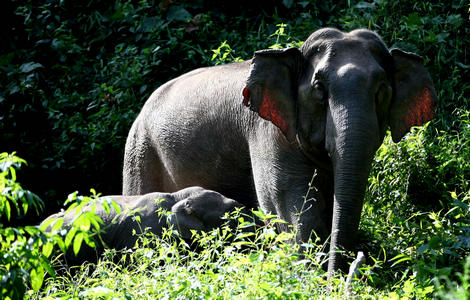
|
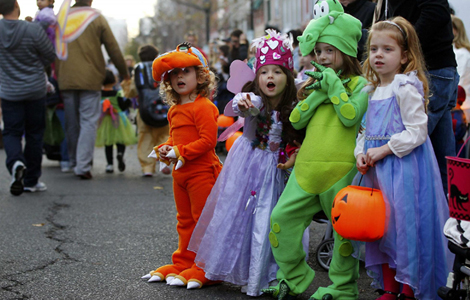
|
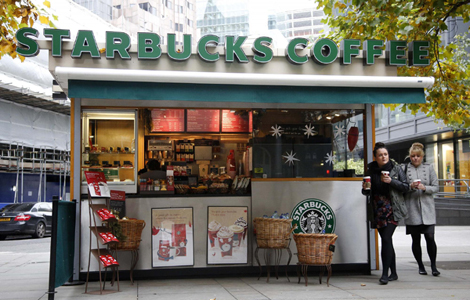
|

|

|
